Post Disclaimer
101 Generator is supported by its audience. When you purchase through links on our site, we may earn an affiliate commission. Learn more
 Generators are a great tool for power backup, particularly in harsh weather with frequent power failures and shortages. But using a generator is not all rosy as it has various shortcomings that make it not fit for everyone facing power failure. Most typically the cost of using a generator and its fuel is not affordable for everyone.
Generators are a great tool for power backup, particularly in harsh weather with frequent power failures and shortages. But using a generator is not all rosy as it has various shortcomings that make it not fit for everyone facing power failure. Most typically the cost of using a generator and its fuel is not affordable for everyone.
Furthermore, its noise is one such annoying thing that wards off many potential customers interested in the long runtime of these secondary power devices.
Generators only promise you an uninterrupted power supply while uninterrupted engine operation is something you have to look out for. This is because the engine of any motorized device will by nature produce the sound and there is no way to get it silenced. But the sound can be silenced after it has been produced. This is exactly why silencers are needed. You can take the example of a gunshot which will be inaudible with a silencer attached to the gun.
Similarly, the silencer attached to a generator will absorb the sound and let you have an uninterrupted and tranquil power supply with stable and clean energy. Using a silencer is pretty much easier for any generator but the real expertise lies in making a great silencer that will block the noise from coming out. You can make a good silencer without having any technical expertise and for doing so you need to follow the instructions provided in our review in the coming passages.
How To Make A Silencer For A Generator
To make a generator silencer you need to have a clear understanding of the process of making it and then execute each step in a very systematic and efficient manner. Making a silencer uses the silencer and mufflers to be assembled into a silencer box that will block the sound waves from coming out of the box thus making your generator quieter and preventing you from being annoyed by the generator buzz.
Given below are the steps for making a generator silencer. Be careful in following each step systematically and don’t jump off directly at the 2nd or 3rd one.
Step 1: Measuring The Dimensions
The silencer box is supposed to hold the generator in it and therefore it should be fitting enough to accommodate your generator. For that purpose, you need to accurately measure the dimensions of your generator and then cut a box with a few extra inches from each side than your generator dimensions.
These extra inches are supposed to accommodate the insulation and ventilation ducts for smooth-sailing installation. If you leave too little space the insulation layer will be hard to put together. In simple words, you have to create a simple caged or framed box that will surround the generator from all sides. This framed box will then be dampened with sound insulators to prevent any sound from leaking from the box.
Step 2: Adding Ventilation
Your silencer box is going to accommodate the generator and will be tightly sealed but a generator requires air circulation and ventilation for proper running and power supply. For this reason, you have to add ventilation support to your generator silencer box and let the generator run effectively like before the silencer box.
The ventilation duct can be added to the roof of framed silencer box giving way to generator emissions leave safely out of the box. You should carefully determine the place of the ventilation duct and also leave a second point for another ventilation duct. This 2nd ventilation duct is meant for passing the clean air inside and the former one was meant for emitting the used air. These two ducts will be working as an inlet and outlet.
Step 3: Sealing The Structure
After building the framed box and putting it around your generator you have to ensure the extra space for two ventilation ducts and sound insulation. After specifying the location for each element, it is time to seal the box so that no sound comes out of these frames and your generator will give you an absolutely quiet operation.
For sealing the exterior surface of the framed box, you can use an isolating layer that will further enhance the sound-dampening insulation. You can also use a thick rubber sheet as an isolating surface that will rescue the sound level produced by the engine. This isolating surface works by reducing the vibrations produced thereby reducing the sound. In addition to a thick rubber sheet, any flexible and durable material can be used as the isolating media.
Step 4: Installing Sound Insulation
You have sealed the exterior and the box is completely framed outside the generator then it is time for you to isolate the generator internally by adding the sound insulation panels. You can use two layers of insulation panels and for improved results, you should leave a layer space between two insulation layers to prevent any leaking of sound.
For insulation media, you can easily purchase it from any retail store. After adding the insulation media, you can use the plywood to bar the insulation and generator to come in direct contact.
Step 5: Completing The Setup
The final step is of assembling and in this step, you ought to put everything together and fit the circuits. You can use screws and screwdrivers to tightly fixate the panels with the silencer box. After putting the screws on frames and panels, you can install the ventilation duct and for easier handling and your convenience, you can also add a handle to the silencer box. This handle will make it more convenient for transport from place to place with the generator as its destination.
The Bottom Line:
Related Articles:
